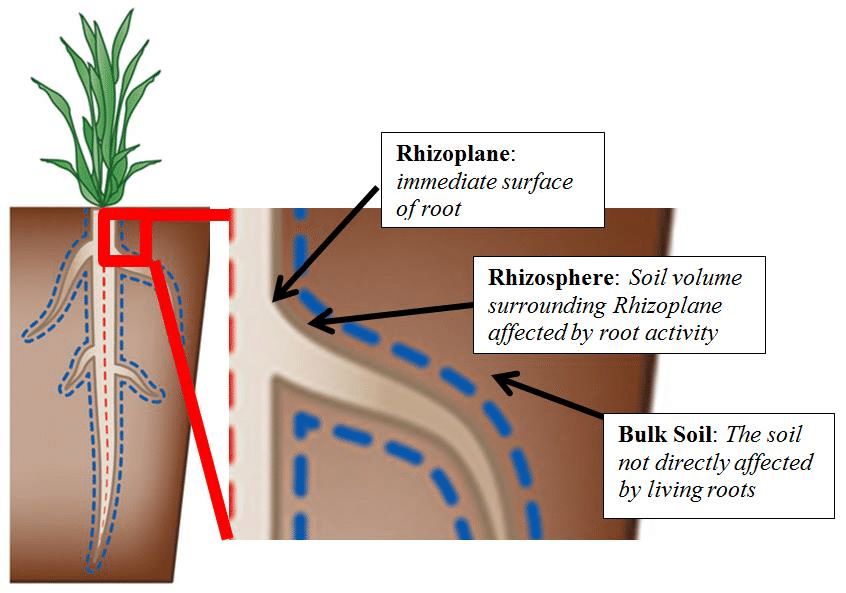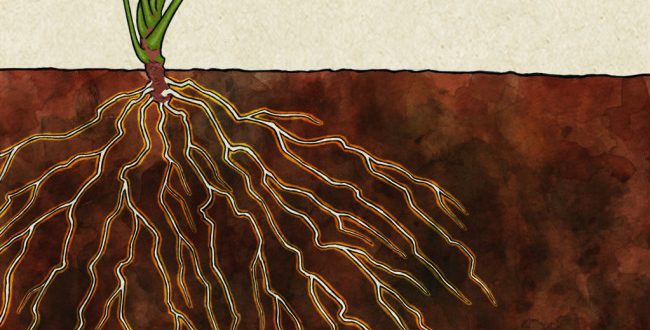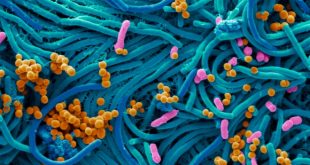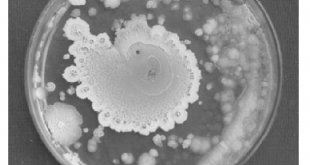Positive and negative interactions take place not only between microbes but also between microbes and plants. The rhizosphere is a zone of predominantly commensal and mutualistic interactions þetween microbes and plants.
Plant roots provide such suitable habitats for the growth of microorganisms that high numbers of different microbial populations are found on and surrounding plant roots. Interactions between soil microorganisms and plant roots satisfy important nutritional requirements for both plant and the associated microorganisms. This is apparent by the large numbers of microorganisms found in the rhizoplane within the rhizosphere.
Rhizoplane
It is the actual surface of the plant root. The rhizoplane is the site of water and nutrient uptake and the release of exudates into the soil.
Rhizosphere
It includes the rhizoplane as the region of soil directly influenced by the plant roots. The rhizosphere is the narrow region of soil that is directly influenced by plant roots. The rhizosphere soil is the thin layer of soil adhering to a root system after shaking has removed the loose soil.
The rhizosphere depends on a particular plant root structure. The fibrous root structure of grassy plants provides a larger surface area than root systems characterized by a taproot.
Soil that is not part of the rhizosphere is known as bulk soil. The rhizosphere contains many bacteria that feed on sloughed-off plant cells, termed rhizodeposition, and the proteins and sugars released by roots. Protozoa and nematodes that graze on bacteria are also more abundant in the rhizosphere. Thus, much of the nutrient cycling and disease suppression needed by plants occurs immediately adjacent to roots.

Rhizosphere Characteristics
- The rhizosphere is a very dynamic environment where plants, soil, microorganisms, nutrients and water meet and interact. The rhizosphere differs from the bulk soil because of the activities of plant toots and their effect on soil organisms.
- A major characteristic of the rhizosphere is the release of organic compounds into the soil by plant roots. These compounds, called exudates make the environment of the rhizosphere very different from the environment in the bulk soil. The exudates increase the availability of nutrients in the rhizosphere, and also provide a carbon source for heterotrophic microorganisms. The exudates cause the number of microorganisms to be far greater in the rhizosphere than in the bulk soil.
- Another characteristic of the rhizosphere is the uptake of water and nutrients by plants. Water is drawn from the surrounding soil towards the roots. The balance between the movement of water and nutrients towards the roots and their removal from the soil by roots means that their concentration in the rhizosphere is usually very different from what it is in the bulk soil. This can affect microbial growth and activity.
Effects of rhizosphere microbial populations on Plants
Microorganisms are able to perform an extremely wide range of chemical transformations, including degradation of organic matter, disease suppression, nutrient transformations inside roots. Microorganisms have marked influence on the growth of plants. In the absence of appropriate microbial populations in the rhizosphere, plant growth may be impaired.
Following are the major effects of microbial populations on plants.
Best safe and secure cloud storage with password protection
Get Envato Elements, Prime Video, Hotstar and Netflix For Free
Best Money Earning Website 100$ Day
#1 Top ranking article submission website
- Microorganisms in the rhizosphere influence the availability of mineral nutrients to the plants. Various root microorganism associations can increase nutrient uptake by plants in nutrient poor environments, such as symbiotic (c.g. mycorrhizal) and other specific (e.g. nitrogen-fixing) associations and rhizobia.
- Organisms in the rhizosphere produce organic compounds that affect the proliferation of the plant root system.
- Microorganisms synthesize auxins and gibberellin-like compounds, and these compounds increase seed germination and the development of root hairs that aid plant growth.
- Azospirillum is a bacterium that commonly lives in the rhizosphere of grasses. Some strains of this organism produce hormones that stimulate plant growth. Other strains of Azospirillum fix atmospheric nitrogen and make it available to the grass.
- Some soil organisms are pathogenic and attack living plant roots.
- They sometimes help in disease suppression.
- Bacillus polymyxa secrete free phosphate group which plants uptake.
Plant Roots effect on Microbial Populations
The structure of the plant root system contributes to the establishment of the rhizosphere microbial populations. There is a higher proportion of gram-negative rod-shaped bacteria and a lower proportion of gram-positive rods, cocci in the rhizosphere than root-free soil. There is also a relatively higher proportion of motile, rapidly growing bacteria, such as Pseudomonas, in the rhizosphere than elsewhere in soil.
Plant root exudates stimulate the growth of the soil microbial population. Organic materials released from roots include amino acids, keto acids, vitamins, sugars, tannins, alkaloids, phosphatides etc. Roots surrounded by microbes excrete many times as many organic materials as sterile roots. Although few of these materials inhibit microbes, most stimulate microbial growth.
Plants secrete many compounds into the rhizosphere which serve different functions. Strigolactones (a plant hormone), secreted and detected by mycorrhizal fungi, stimulate the germination of spores and initiate changes in the mycorrhiza that allow it to colonize the root. Symbiotic nitrogen-fixing bacteria, such as the Rhizobium species, attracted by t lectins (plant proteins), tryptophan will lead to the formation of root nodules.
Non-symbiotic (or ‘free-living’) nitrogen-fixing bacteria may reside in the rhizosphere just outside the roots of certain plants (including many kinds of grass), and singularly “fix” nitrogen gas in the nutrient-rich rhizosphere. Even though these organisms are thought to be only loosely associated with the plants they inhabit, they may respond very strongly to the stages of the plants.
Rhizosphere Effect and R/S Ratio
Within the rhizosphere, plant roots have a direct influence on the composition and density of the soil microbial community, known as the rhizosphere effect. The rhizosphere effect can be seen by looking at the ratio of the number of microorganisms in the rhizosphere soil (R) to the number of corresponding microorganisms in soil remote from roots (S), which is known as R/S ratio.
Generally, R/S ratio ranges from 5 to 20, but it is common to find an R/S ratio of 100, that is, microbial populations 100 times higher in the rhizosphere than in the surrounding root-free soil. The actual extent of the rhizosphere effect depends on the particular plant and its physiological maturity,
Revised by
- Md. Siddiq Hasan on 19 March, 2020
 Plantlet The Blogging Platform of Department of Botany, University of Dhaka
Plantlet The Blogging Platform of Department of Botany, University of Dhaka





